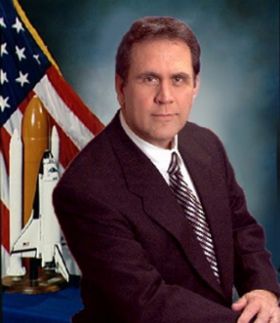Welcome to Indigenous Futures in Engineering, Queen's University
Search
Jerry C. High Eagle

Type(s) of Engineering:
Aerospace"The freedom and creativity together with the opportunity to see into the future through the inventions of NASA engineers." "Engineering is a sacred profession. It learns about many of the Great Spirit's secrets left here for us to discover and to use for our benefit."
Jerry High Eagle remembers clearly what first made him want to study science.
"I always had an inquisitive mind. I loved to put puzzles together and build things when I was young. When I was younger, I remember hearing about the Russians beating the United States into space, and launching a satellite into orbit around the Earth. That day, I realized suddenly that here I was in a small town that was never really going to change much, yet there in the news was something out of the future. And I wanted to go there!"
His family were very supportive of his dreams.
"My family supported me, especially my Grandfather and Mother, to stay in school and get an education. I am the first member of my family to have a college education with degree."
Mr. High Eagle's degree allowed him to witness history first hand, and even to play a part in it. While still a graduate student at university, Mr. High Eagle was recruited by NASA where he soon joined the Moon program. In 1969, when the Apollo 11 Lunar Module (named Eagle) landed on the moon, he was a flight controller in NASA's Mission Control Centre in Houston, Texas. His duties included computing all the parameters which allowed the rocket carrying Neil Armstrong, Buzz Aldrin and Michael Collins to take off and land safely. He says it was the most exciting project on which he has ever worked.
About a year later, Mr. High Eagle had his greatest professional challenge and achievement when he was an operations flight controller during the Apollo 13 (Odyssey) mission. Astronauts Jim Lovell and Fred Haise, were supposed to land the lunar module Aquarius in the Fra Mauro hills of the moon, conduct experiments, take photos and collect moon rocks, while John Sweigart orbited the moon in the Odyssey capsule. About 320,000 km from Earth, after they had docked with the Aquarius but before they reached the moon, one of the Odyssey's oxygen tanks exploded, damaging the ship and leaving it without power and air. The flight engineers at NASA found out about the problem when Jim Lovell radioed back, "Okay, Houston, we've have a problem ..."
NASA engineers and scientists decided that the safest way to bring the Apollo 13 crew home was to abandon the moon landing but let them orbit the moon once. This way they could use the moon's gravity to help slingshot them back towards Earth. Mr. High Eagle was in charge of computing the return-to-earth trajectory, the path which would bring the astronauts safely home.
"I participated in the greatest challenge and noblest adventure in mankind's history. The successful return of Apollo 13 is a story of strong determination in the face of suspense and tragedy, but technical competence mixed with plain, old-fashion common sense, made us fearless and undaunted."
For his part in the Apollo 13 mission, Mr. High Eagle was presented by with his nation' s highest civilian honour, the Presidential Medal of Freedom.
Today, Mr. High Eagle continues to work at NASA in the Office of Technology Transfer and Commercialisation. Part of his job is to do technical evaluations of NASA inventions and research and then figure out how they might be used to benefit society. While this is a field completely different from flight control, Mr. High Eagle feels his engineering background has prepared him for the challenge,
"Engineering fine-tuned my ability to reason, to think. With its knowledge and principles, I could apply information to anything It gave me a better sense of confidence in myself Engineers and scientists are doers. We are thinkers, and like to build things. We like to figure things out. We are educated to deal in facts and to be logical in our thinking, but we are people too! To be a good scientist or engineer is to be a good human with care and concern for both humanity and the environment.
"Mr. High Eagle is not only an accomplished scientist, he is also a musician and an activist. He has performed on the American Indian flute with the National Symphony at the John F. Kennedy Centre for Performing Arts. He also designed an international site for peace which lies on the equator in the South American country of Ecuador.
Mr. High Eagle believes education, and particularly science and engineering education, are essential for the future of Aboriginal peoples.
"We cannot ignore that the future of our people will clearly depend on the presence of well-trained, well-educated engineers and others in technical fields. Whatever we plan or do to meet the future needs of our people will not happen unless you make it happen. We will be successful in our efforts to achieve a better tomorrow only if you have the will, the energy, and the desire to bring it about. Remember no person can be better than their own preparation. Without education, we cannot survive.
I challenge you who are proud of your family, proud of your heritage, to achieve an education that will make the future point to you with even more pride than the present. I challenge you to accomplish more than those of us who have gone before you; I challenge you to shoulder more responsibility, to launch out into the deep and do something; I challenge you to make life obey you, not you obey it."
See also:
Jerry High Eagle, Assistant Chief Technologist: STEM Profile (Challenger Center)
Native American Heritage Month profile (adafruit)
Science: A spriritual journey of discovery (Science)
Native American Connections biography (NASA)
